Open Boats Get a Lot More Use Than Yachts
New Zealand is a paradise for those who love to go cruising. The entire population of New Zealand is just over 4.5 million. The country’s coastline totals 15,134 kilometers, and most of it is not populated. So there’s always a white sand beach or a rocky cove where a small open boat can anchor or tie up for the night.
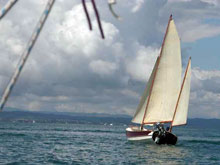 |
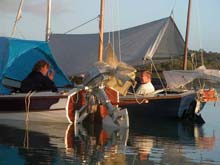 |
New Zealand is a paradise for those who love to go cruising. |
Why cruise in an open boat?
The city of Auckland, on the north island in New Zealand, is called the city of sails, partly because the citizens of Auckland own more pleasure boats per capita than any other city in the world. From here, the Kiwis launched their successful America’s Cup bid. And weekends see thousands and thousands of New Zealanders setting sail for the offshore islands that dot the Hauraki Gulf.
Most of the cruisers leave from one of Auckland’s 17 yacht clubs, but a growing number arrive at the public launching ramp with a small open boat on a trailer behind the family car. In a few minutes, they’ve floated their little boats, set up the rigging, loaded supplies and gear, parked the car and trailer in the free public parking lot, and they’re ready to shove off.
Michael Barraclough, an avid cruiser, says. “I owned a 6-meter FRP boat, but I only used it about eight times in as many years. So I sold it. I started looking at open boat designs. One in particular, a boat designed by John Welsford called Navigator; one that I’d seen years earlier featured in Boating magazine, remained in my mind. I got the impression it was suitable for voyaging and yet small enough to beach.
“To make a long story short, I took two years to build my Navigator. And it’s so easy to tow, launch, and sail, that it has been used more in a year than the 20-ft yacht was in eight years.”
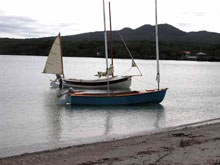 |
 |
"New Zealand has miles and miles of beautiful bays and coves, wooded headlands, superb scenery, and wonderful beachside camping.” |
Peter Korten’s story is much the same. “I came to New Zealand from Britain in 1975,” he explained. Almost at once I bought a Midnight 21 trailer sailer, which I sailed in Wellington harbor, Queen Charlotte Sound, and the Bay of Islands. Then I switched to a Noelex 25 that I sailed for 15 years. While the Noelex was a trailer sailer, she was too big to launch from the beach every weekend. I tried an aluminum boat and hated it. Then I came across the Navigator. It looked so great that a friend and I built one and named her Kotuku. Since we finished Kotuku in 2004, we’ve raced her every summer Sunday and cruised around Kapiti Island. Miles and miles of beautiful bays and coves, wooded headlands, superb scenery, and wonderful beachside camping.”
John Welsford’s designs include three that have proved popular with open boat cruisers – Houdini, Navigator, and Pathfinder. Nearly a thousand of these boats have been built worldwide, mostly by their owners. And while all the open boats that cruise out of Auckland are not Welsford’s, a considerable group of his boats’ owners gather of a weekend to cruise the inner islands of the Hauraki Gulf.
The cruising open boat
“There are many things to recommend a cruising dinghy,” Welsford says. “For one thing, all the maintenance on it can be done in the garage or car port, at night or on winter weekends. What’s more, you can get the boat set up and loaded with stores and gear before you ever leave home, so when you get to the water, everything’s completely ready.”
Someone considering cruising in a small boat faces several choices. Most of them will use their boat as a family daysailer when not cruising, and that needs to be considered when choosing it. A family with two teenage sons needs a different craft from the one with an active grammar schooler.
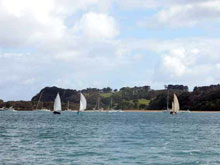 |
 |
Someone considering cruising in a small boat faces several choices. Most of them will use their boat as a family daysailer when not cruising. |
Then there’s the kind of cruising you plan to do. In New Zealand, Welsford says people who cruise in small boats can be divided into two types: those who sleep on board the boat and those who camp ashore. The former need a boat big enough to stretch out in while if the latter can get to a place to go ashore and set up a tent, that’s enough.
But what about the boat itself?
“The top priority is a boat that doesn’t require constant attention to keep her upright and on course,” Welsford says. “Look for high stability, so crew position is not critical when sailing, a rig that doesn’t need constant trimming, a large centerboard that will hang on at low speeds, and comfortable seating. Consider this: if the boat is demanding or uncomfortable, even a short voyage will be tiring, and a tired crew is more likely to make costly mistakes.”
He continues: “You’ll want the centerboard case top opening to be above the water if the boat is ever swamped. If not, you’ll never be able to bail her out. Good freeboard, a foredeck and coamings to keep the spray out would be advisable, too.”
Welsford says the rig is especially important. Above all, you should be able to shorten sail while at sea, he says. “I think a two-masted rig has a lot to offer the small cruiser. My aim in specifying such rigs in my own designs is to have a boat that will heave to with its head to the wind, and one that will balance well under jib and mizzen as well, and that means a safer rig in an unexpected squall.”
Of course the small open cruiser must have an alternative means of propulsion. Some choose oars, but most rely on outboard motors. Welsford says he prefers to design his boats so there’s an inboard well for the motor. “You don’t want to be hanging out over the transom in 2-meter steep and breaking seas,” he notes.
Finally, the small cruising boat still must have room enough for stores and equipment. “It’s got to have space to stow all the crew’s requirements for shelter, sleeping, cooking, food, and water. The stowage can be a place to strap waterproof containers, drybags, and boxes, or it can be lockers big enough to take all of the gear as well as what’s necessary for the boat in terms of ground tackle and safety equipment.”
Welsford’s boats all have lockers located beneath the seats and under the foredeck. All are accessible through watertight hatches and screw ports.
What about size?
Welford’s most popular design, with well over 600 plans sold around the globe, is Navigator, a small 14 footer. But he points out that Englishman and writer Roger Barnes sails a clinker-built Tideway dinghy to great effect. “I’ve been cruising open boats for longer than I care to remember,” says Welsford, “ and I’ve had some terribly exciting moments, along with innumerable glorious days and incredibly wonderful memories.”
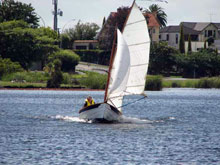 |
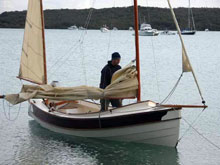 |
Welsford says. “Look for high stability, so crew position is not critical when sailing, a rig that doesn’t need constant trimming, a large centerboard that will hang on at low speeds, and comfortable seating." |
Open water cruising
Summertime in New Zealand is cruising time, to be sure, but it’s also regatta time, with several major events held in cities as diverse as Wellington, Nelson, and Auckland. On the anniversary of Auckland’s founding, boats gather at Scott’s Landing for the Mahurangi Classic Boat Regatta. In 2006, 14 Welsford cruising dinghies lined up at the beach in front of the regatta committee’s headquarters. Among them, Jaunty, a 14-ft Navigator owned by Dave Perillo. Light-blue Jaunty is Dave’s second Navigator. His first one, Margaret H, was left behind in Fiji, where Dave cruised her for 10 months.
We sailed Jaunty through the 300-boat classic regatta fleet with Dave at the tiller, his perennial Cheshire-cat grin lighting up his face. With a little jogging, he spoke of his months cruising the Yasawa islands in Fiji.
Dave shipped his Navigator to Fiji on a freighter, but after she was off-loaded, the boat took him everywhere in the islands. “I was totally impressed with the Navigator,” Dave said. “I made so many offshore cruisers envious of that little boat that I know at least a few of them will be downsizing when they return home.”
On his first day out in Margaret H, sailing for Waya, the southernmost in the Yasawa group, Dave felt misgivings. Was he stupid to ship his boat to Fiji. Then, still eight miles short of the island, bang! The mizzen snapped, giving Dave one more worry, one more thing to bear.
“The day started out a beautiful 5-knot morning and turned into a 35-knot nightmare. Those seas were a lot bigger than anything my little lugger had ever seen before. Still, I was living a lifelong dream. I had to go on.
“I couldn’t point high enough to make Waya so I had to turn downwind and make for Navrada, an uninhabited island 12 miles south. With the main dropped and the jib half furled, I still made incredible way. That wind was sorting men from boys, and this boy was out there all alone.”
Two hours in 35-knot winds put Dave at the mouth of a quiet harbor on Navrada’s lee shore. “That harbor was an incredibly beautiful place,” Dave said with his Cheshire-cat grin. “All my doubts flew away. My reason for being in Fiji was as clear as the water I sailed over. When I got to the beach, I knelt and kissed the sand. The joy of having survived gave me a feeling of pride that guys sailing big boats can never get.”
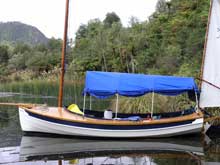 |
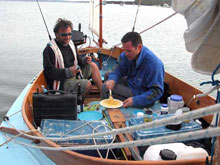 |
The small cruising boat must have room enough for stores and equipment. “It’s got to have space to stow all the crew’s requirements for shelter, sleeping, cooking, food, and water. |
The idea of cruising in a open boat came from years of adventuring around Hauraki Gulf in yachts. While that was a lot of fun, most of it was through the endless stream of guests who left the maintenance, marina, insurance, anchoring and all those bloody awful and ridiculously expensive other things to Dave. It was time to become selfish! A boat for one and an eight month cruise with no real time table and very little expense. Dave sold his house and business, and set out to make his dreams come true.
“That first landfall in Navrada set the stage for all that followed. Hungry, I assembled my Sage RPLXi 9 weight fly rod, selected a big fat blue and white deceiver and cast my line. The fly had barely splashed down and - bang –it’s gobbled by a fat little trevally, which I reeled in through the unbelievably transparent water. I stopped fishing at once and set about cleaning the little beastie. As if to confirm that nothing could be better than this, a trio of black-tip reef sharks, less than a meter long, came to eat the entrails. I watched them, amazed at my good fortune to see such a sight. . .”
Dave’s advice on sailing Fiji is succinct. “There seem to be more reefs than open water, with uncharted coral heads popping up all over the place. Not cause for too much concern in my Margret H with her swing keel and shallow draft. But in a large yacht, you have be more vigilant. GPS is a big help, but it’s by no means ‘the answer’. The chart for the Yasawas ("F5"), is hopelessly inaccurate. I regularly came across large reefs and bombies that didn’t show up on the chart.”
Our sail in Jaunty came to an end too quickly. Instead of more stories about cruising Margaret H in Fiji, Dave grinned as we walked up the beach at Scott’s Landing and said, “I could tell you about a terrifying trip in a trade wind so powerful it snapped my new mizzen like a twig; how I built a great little grass mbure hut with the local chief's blessing right on the beach at the blue lagoon where I lived for three months; about the manta rays; the kava drinking sessions that had no end; about the weddings and the chiefly ceremonies that few mbavalangi (if any) had ever seen. Just let me say this: if you've got a dream, go and live it today.”
Navigator at home in New Zealand
Avid open boat cruiser Michael Barraclough says, “Its hard to pick a best moment in my Navigator, each trip is an adventure with friends or family. With my brother and sisters, we did a full day sail out of Kawakawa Bay and across the Firth of Thames to Waiomu, which is north of Thames.”
 |
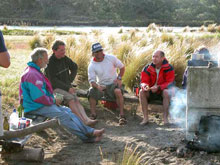 |
Avid open boat cruiser Michael Barraclough says, “Its hard to pick a best moment in my Navigator, each trip is an adventure with friends or family. |
With the wind at 25 knots instead of the predicted 5-10, Michael and his passengers were a bit reticent about heading out, but they discussed backup plans of what to do if they got out and the wind got too strong, they sailed out on the firth. “We had the last laugh,” Michael says, “the 25-knot blow was just the wind whistling around the point. As soon as we rounded Orere point, the wind moderated and a more pleasant trip could not be imagined!”
On the cruise, Michael and his crew had close encounters of the natural kind, including penguins, gannets, and a shark. “The shark refused to circle us,” he says, “so I tried to circle the shark. It wasn’t impressed and disappeared, leaving us to continue our cruise without its company.”
Approaching the far shore, a good-natured argument arose as to the exact bearing to Waiomu. “We decided to land and ask were we were,” Michael says, “only to find we had made perfect landfall.
“Our shore crew had bought the trailer over, so and after loading up the Navigator, we spent the evening in a rented batch with a hot shower followed by a bottle of beer. Ahh, the convenience of a small trailerable boat.”
Literally hundreds of people mirror Dave’s and Michael’s adventures every weekend in New Zealand. In ages past, Vikings left their fiords in open boats on voyages of adventure. Today, an entire flotilla of open cruising boats follows their tradition below the Southern Cross. Sons of Vikings indeed.
# # #
Charles T. Whipple |

